Reading: The Decade That Roared
The Decade That Roared
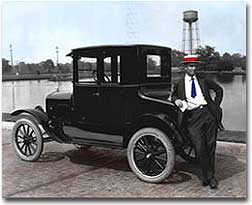
The 1920s saw the culmination of fifty years of rapid American industrialization. New products seemed to burst from American production lines with the potential of revolutionizing American life. Other products that had previously been toys for the rich were now available to a majority of Americans. The standard of living increased as the economy grew stronger and stronger. The results were spectacular. The America of 1929 was vastly different from the America of 1919.
The automobile was first and foremost among these products. The practices of Henry Ford made these horseless carriages affordable to the American masses. Widespread use of the automobile ushered in changes in work patterns and leisure plans. A host of support industries were launched. Dating and education were changed by the automobile. Radio usage brought further changes. For the first time, a national popular culture was supplanting regional folkways. Americans across the continent were sharing the same jokes, participating in the same fads, and worshipping the same heroes. Housework was minimized with the introduction of labor saving devices. As a result, leisure time was increased.
The bleak outlook and large sacrifices of the wartime era were now a part of the past. Young Americans were looking to cut loose and have a good time. Prohibition did not end alcohol usage. The romantic subculture of the speakeasy kept the firewater flowing. Organized crime flourished as gangland violence related to bootlegged liquor plagued America's cities. Flapper women strove to eliminate double standard values. Young females engaged in behaviors previously reserved for men including smoking and drinking. Sigmund Freud's assertion that sexual behavior was a natural instinct brought down more barriers as young Americans delved into sexual experimentation. The Harlem Renaissance brought a new form of entertainment. The sounds of jazz bands had appeal that transcended African American audiences, as thousands flocked to hear the new sounds.
The 1920s ushered in more lasting changes to the American social scene than any previous decade. Escapism loomed large as many coped with change by living in the present and enjoying themselves. The economic boom that unleashed the transformation and its consequences made the Roaring Twenties an era to remember.
The Age of the Automobile
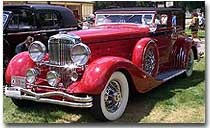
Cruising in automobiles such as the Duesenberg pictured above was popular in America, but this typically Sunday afternoon family past time was largely discontinued during the depression.
Perhaps no invention affected American everyday life in the 20th century more than the automobile.
Although the technology for theAUTOMOBILE existed in the 19th century, it took HENRY FORD to make the useful gadget accessible to the American public. Ford used the idea of theASSEMBLY LINE for automobile manufacturing. He paid his workers an unprecedented $5 a day when most laborers were bringing home two, hoping that it would increase their productivity. Furthermore, they might use their higher earnings to purchase a new car.
Ford reduced options, even stating that the public could choose whatever color car they wanted — so long as it was black. The MODEL T sold for $490 in 1914, about one quarter the cost of the previous decade. By 1920, there were over 8 million registrations. The 1920s saw tremendous growth in automobile ownership, with the number of registered drivers almost tripling to 23 million by the end of the decade.
Economic Spin-offs
The growth of the AUTOMOBILE INDUSTRY caused an economic revolution across the United States. Dozens of spin-off industries blossomed. Of course the demand for vulcanized rubber skyrocketed. Road construction created thousands of new jobs, as state and local governments began funding highway design.
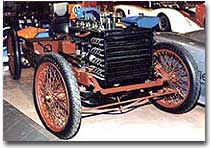
Even the federal government became involved with the FEDERAL HIGHWAY ACT OF 1921. GAS STATIONS began to dot the land, and mechanics began to earn a living fixing the inevitable problems. Oil and steel were two well-established industries that received a serious boost by the demand for automobiles. Travelers on the road needed shelter on long trips, so MOTELS began to line the major long-distance routes.
Even cuisine was transformed by the automobile. The quintessential American foods — hamburgers, french fries, milk shakes, and apple pies — were hallmarks of the new roadside DINER. Drivers wanted cheap, relatively fast food so they could be on their way in a hurry. Unfortunately, as new businesses flourished, old ones decayed. When America opted for the automobile, the nation's rails began to be neglected. As European nations were strengthening mass transit systems, individualistic Americans invested in the automobile infrastructure.
Effects of the Automobile
The social effects of the automobile were as great. Freedom of choice encouraged many family vacations to places previously impossible. Urban dwellers had the opportunity to rediscover pristine landscapes, just as rural dwellers were able to shop in towns and cities. Teenagers gained more and more independence with driving freedom. Dating couples found a portable place to be alone as the automobile helped to facilitate relaxed sexual attitudes.
Americans experienced TRAFFIC JAMS for the first time, as well as traffic accidents and fatalities. Soon demands were made for licensure and safety regulation on the state level. Despite the drawbacks, Americans loved their cars. As more and more were purchased, drivers saw their worlds grow much larger.
The Fight Against "Demon Rum"
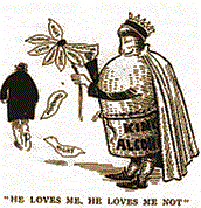
Prohibition Political cartoons, both for and against, sprouted up during the 1920s
Saloons were closed, bottles were smashed, and kegs were split wide open. When the states ratified the EIGHTEENTH AMENDMENT in 1919, the manufacture, sale, and transportation of alcoholic beverages was outlawed. Protestant ministers and progressive politicians rejoiced and proclaimed a holier and safer America. It was predicted that worker productivity would increase, families would grow closer, and urban slums would disappear. Yet for all its promise, prohibition was repealed fourteen years later, after being deemed a dismal failure.
Advantages to Prohibition
In fairness, there were advantages to prohibition. Social scientists are certain that actual consumption of alcohol actually decreased during the decade. Estimates indicate that during the first few years of prohibition, alcohol consumption declined to a mere third of its prewar level. Although no polls or surveys would be accurate, health records indicate a decrease in alcoholism and alcohol-related diseases such as cirrhosis of the liver. Family savings did increase during the decade, but it was difficult to determine whether the increase was due to decreased alcohol consumption or a robust economy.
Disadvantages to Prohibition
The minuses seemed to outweigh the pluses. First, federal allocation of funds to enforce prohibition were woefully inadequate. Gaping loopholes in theVOLSTEAD ACT, the law implemented to enforce the Eighteenth Amendment, encouraged abuse. Alcohol possession was permitted for medical purposes, and production of small amounts was permitted for home use. The manufacturing of NEAR BEER — regular beer without the alcohol — was also permitted. The problem was that to make near beer, it was first necessary to brew the real variety, so illegal breweries could insist their product was scheduled to have the alcohol removed. Soon a climate of lawlessness swept the nation, as Americans everywhere began to partake in illegal drink. Every city had countless SPEAKEASIES, which were not-so-secret bars hidden from public view.
While the number of drinkers may have decreased, the strength of the beverages increased. People drank as much as they could as fast as they could to avoid detection. Because alcoholic production was illegal, there could be no regulation. Desperate individuals and heartless profiteers distilled anything imaginable, often with disastrous results. Some alcohol sold on the black market caused nerve damage, blindness, and even death. While women of the previous generation campaigned to ban alcohol, the young women of the twenties consumed it with a passion.
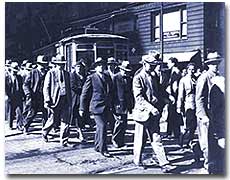
Organized Crime
The group that profited most from the illegal market was ORGANIZED CRIME. City crime bosses such as AL CAPONE of Chicago sold their products to willing buyers and even intimidated unwilling customers to purchase their illicit wares. Crime involving turf wars among mobsters was epidemic. Soon the mobs forced legitimate businessmen to buy protection, tainting those who tried to make an honest living. Even city police took booze and cash from the likes of Al Capone. After several years of trying to connect Capone to BOOTLEGGING, federal prosecutors were able to convict him for income tax evasion.
The Eighteenth Amendment was different from all previous changes to the Constitution. It was the first experiment at social engineering. Critics pointed out that it was the only amendment to date that restricted rather than increased individual rights. Civil liberties advocates considered prohibition an abomination. In the end, economics doomed prohibition. The costs of ineffectively policing the nation were simply too high. At the deepest point of the Great Depression, government officials finally ratified the TWENTY-FIRST AMENDMENT, repealing the practice once and for all.
The Invention of the Teenager
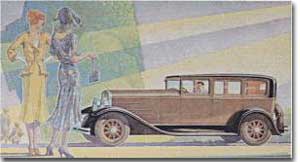
The automobile was monumental in the evolution of courtship. High speed and moonlight drives inspired a spirit of reckless abandon.
In the 19th century, the American world consisted of children and adults. Most Americans tried their best to allow their children to enjoy their youth while they were slowly prepared for the trials and tribulations of adulthood. Although child labor practices still existed, more and more states were passing restrictions against such exploitation. The average number of years spent in school for young Americans was also on the rise. Parents were waiting longer to goad their youngsters into marriage rather than pairing them off at the tender age of sixteen or seventeen. In short, it soon became apparent that a new stage of life — the TEENAGE phase — was becoming a reality in America. American adolescents were displaying traits unknown among children and adults. Although the word teenager did not come into use until decades later, the teenage mindset dawned in the 1920s.
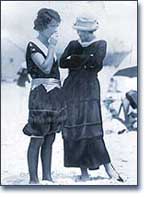
From Courtship to Dating
The single greatest factor that led to the emergence of the independent teenager was the automobile. Teens enjoyed a freedom from parental supervision unknown to previous generations. The courtship process rapidly evolved into dating. In earlier times, young boys and girls spent their first dates at home. The boy would meet the girl's parents, they would have a sitting in the parlor, followed by dinner with the entire family. Later in the evening, the couple might enjoy a few moments alone on the front porch. After several meetings, they could be lucky enough to be granted permission for an unchaperoned walk through town. The automobile simply shattered these old-fashioned traditions. Dating was removed from the watchful eyes of anxious parents. Teenagers were given privacy, and a sexual revolution swept America. Experimentation with sexual behaviors before marriage became increasingly common. Young Americans were now able to look beyond their own small towns at an enlarged dating pool.
Impact of the Automobile
Automobile technology led directly to the other major factor that fostered a teenage culture: the consolidated HIGH SCHOOL. Buses could now transport students farther from their homes, leading to the decline of the one-room schoolhouse. Furthermore, Americans were realizing the potential of a longer education, and states were adding more years to their compulsory schooling laws. As a result, a larger number of teenagers were thrown into a common space than ever before. It was only natural that discussions about commonalties would occur. Before long, schools developed their own cultural patterns, completely unlike the childhood or adult experience. School athletics and extracurricular activities only enhanced this nascent culture. The American teenager was born.
Flappers
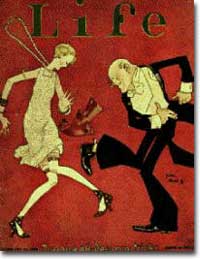
The battle for suffrage was finally over. After a 72-year struggle, women had won the precious right to vote. The generations of suffragists that had fought for so long proudly entered the political world. Carrie Chapman Catt carried the struggle into voting awareness with the founding of the League of Women Voters. Alice Paul vowed to fight until an EQUAL RIGHTS AMENDMENT was added to the Constitution.MARGARET SANGER declared that female independence could be accomplished only with proper BIRTH CONTROL methods. To their dismay, the daughters of this generation seemed uninterested in these grand causes. As the 1920s roared along, many young women of the age wanted to have fun.
Life of the Flappers
FLAPPERS were northern, urban, single, young, middle-class women. Many held steady jobs in the changing American economy. The clerking jobs that blossomed in the Gilded Age were more numerous than ever. Increasing phone usage required more and more operators. The consumer-oriented economy of the 1920s saw a burgeoning number of department stores. Women were needed on the sales floor to relate to the most precious customers — other women. But the flapper was not all work and no play.
By night, flappers engaged in the active city nightlife. They frequented jazz clubs and vaudeville shows. Speakeasies were a common destination, as the new woman of the twenties adopted the same carefree attitude toward prohibition as her male counterpart. Ironically, more young women consumed alcohol in the decade it was illegal than ever before. Smoking, another activity previously reserved for men, became popular among flappers. With the political field leveled by the Nineteenth Amendment, women sought to eliminate social double standards. Consequently, the flapper was less hesitant to experiment sexually than previous generations. SIGMUND FREUD's declaration that the libido was one of the most natural of human needs seemed to give the green light to explore.
The Flapper Look
The flapper had an unmistakable look. The long locks of Victorian women lay on the floors of beauty parlors as young women cut their hair to shoulder length. Hemlines of dresses rose dramatically to the knee. The cosmetics industry flowered as women used make-up in large numbers. Flappers bound their chests and wore high heels. CLARA BOW, Hollywood's "It" Girl, captured the flapper image for the nation to see.
Many women celebrated the age of the flapper as a female declaration of independence. Experimentation with new looks, jobs, and lifestyles seemed liberating compared with the socially silenced woman in the Victorian Age. The flappers chose activities to please themselves, not a father or husband. But critics were quick to elucidate the shortcomings of flapperism. The political agenda embraced by the previous generation was largely ignored until the feminist revival of the 1960s. Many wondered if flappers were expressing themselves or acting like men. Smoking, drinking, and sexual experimentation were characteristic of the modern young woman. Short hair and bound chests added to the effect. One thing was certain: Despite the potential political and social gains or losses, the flappers of the 1920s sure managed to have a good time.
The Harlem Renaissance
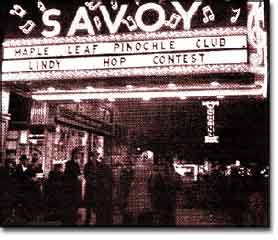
The Savoy Ballroom in Harlem in 1926 was The Place and Lindy Hop was The Dance!
It was time for a cultural celebration. African Americans had endured centuries of slavery and the struggle for abolition. The end of bondage had not brought the promised land many had envisioned. Instead, WHITE SUPREMACYwas quickly, legally, and violently restored to the New South, where ninety percent of African Americans lived. Starting in about 1890, African Americans migrated to the North in great numbers. This GREAT MIGRATION eventually relocated hundreds of thousands of African Americans from the rural South to the urban North. Many discovered they had shared common experiences in their past histories and their uncertain present circumstances. Instead of wallowing in self-pity, the recently dispossessed ignited an explosion of cultural pride. Indeed, African American culture was reborn in the HARLEM RENAISSANCE.
The Great Migration
The Great Migration began because of a "push" and a "pull." Disenfranchisement and Jim Crow laws led many African Americans to hope for a new life up north. Hate groups and hate crimes cast alarm among African American families of the Deep South. The promise of owning land had not materialized. Most blacks toiled as sharecroppers trapped in an endless cycle of debt. In the 1890s, a boll weevil blight damaged the cotton crop throughout the region, increasing the despair. All these factors served to push African Americans to seek better lives. The booming northern economy forged the pull. Industrial jobs were numerous, and factory owners looked near and far for sources of cheap labor.
Unfortunately, northerners did not welcome African Americans with open arms. While the legal systems of the northern states were not as obstructionist toward African American rights, the prejudice among the populace was as acrimonious. White laborers complained that African Americans were flooding the employment market and lowering wages. Most new migrants found themselves segregated by practice in run down urban slums. The largest of these was Harlem. Writers, actors, artists, and musicians glorified African American traditions, and at the same time created new ones.
Writers and Actors
The most prolific writer of the Harlem Renaissance was LANGSTON HUGHES. Hughes cast off the influences of white poets and wrote with the rhythmic meter of blues and jazz. CLAUDE MCKAY urged African Americans to stand up for their rights in his powerful verses. JEAN TOOMER wrote plays and short stories, as well as poems, to capture the spirit of his times. Book publishers soon took notice and patronized many of these talents. ZORA NEALE HURSTONwas noticed quickly with her moving novel, THEIR EYES WERE WATCHING GOD. Music met prose in the form of musical comedy. The 1921 production ofSHUFFLE ALONG is sometimes credited with initiating the movement. ActorPAUL ROBESON electrified audiences with his memorable stage performances.
Musicians
No aspect of the Harlem Renaissance shaped America and the entire world as much as jazz. JAZZ flouted many musical conventions with its syncopated rhythms and improvised instrumental solos. Thousands of city dwellers flocked night after night to see the same performers. IMPROVISATION meant that no two performances would ever be the same. Harlem's COTTON CLUBboasted the talents of DUKE ELLINGTON. Singers such as BESSIE SMITH andBILLIE HOLIDAY popularized blues and jazz vocals. JELLY ROLL MORTON andLOUIS ARMSTRONG drew huge audiences as white Americans as well as African Americans caught jazz fever.
The continuing hardships faced by African Americans in the Deep South and the urban North were severe. It took the environment of the new American city to bring in close proximity some of the greatest minds of the day. Harlem brought notice to great works that might otherwise have been lost or never produced. The results were phenomenal. The artists of the Harlem Renaissance undoubtedly transformed African American culture. But the impact on all American culture was equally strong. For the first time, white America could not look away.
A Consumer Economy
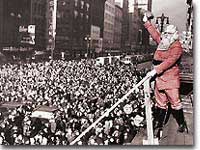
Santa waves to children outside a department store during a Thanksgiving Day Parade.
The 1920s was a decade of increasing conveniences for the middle class. New products made household chores easier and led to more leisure time. Products previously too expensive became affordable. New forms of financing allowed every family to spend beyond their current means. ADVERTISING capitalized on people's hopes and fears to sell more and more goods.
Changing Housework
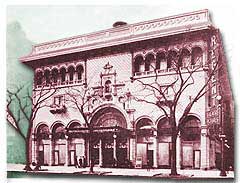
The Regent Theater, America's First Movie Palace
By the end of the 1920s,HOUSEHOLD WORK was revolutionized. A typical work week for a housewife before the twenties involved many tedious chores. All the furniture was moved off the carpets, which were rolled up and dragged outside to beat out the week's dirt and dust. The ice in the icebox was replaced and the waterpan that lay beneath was repeatedly changed. The clothes were scrubbed in a washing tub on a washboard. An iron was heated on the stove to smooth out the wrinkles. Women typically spent the summer months canning food for the long winter. Clothes were made from patterns, and bread was made from scratch. Very few of these practices were necessary by the end of the decade. Vacuum cleaners displaced the carpet beater. Electric refrigerators, washing machines, and irons saved hours of extra work. New methods of canning and freezing made store-bought food cheap and effective enough to eliminate this chore. Off-the-rack clothing became more and more widespread. Even large bakeries were supplying bread to the new SUPERMARKETS. The hours saved in household work were countless.
Buying on Credit
"BUY NOW, PAY LATER" became the credo of many middle class Americans of the ROARING TWENTIES. For the single-income family, all these new conveniences were impossible to afford at once. But retailers wanted the consumer to have it all. DEPARTMENT STORES opened up generous LINES OF CREDIT for those who could not pay up front but could demonstrate the ability to pay in the future. Similar INSTALLMENT PLANS were offered to buyers who could not afford the lump sum, but could afford "twelve easy payments." Over half of the nation's automobiles were sold on CREDIT by the end of the decade. America's consumers could indeed have it all, if they had an iron stomach for debt. Consumer debt more than doubled between 1920 and 1930.
Advertising
Fueling consumer demand were new techniques in advertising. This was not a new business, but in the increasingly competitive marketplace, manufacturers looked to more and more aggressive advertising campaigns. One major trend of the decade was to use pop psychology methods to convince Americans that the product was needed. The classic example was the campaign for Listerine. Using a seldom heard term for bad breath — halitosis — Listerine convinced thousands of Americans to buy their product. Consumers might not have known what halitosis was, but they surely knew they did not want it.
Advertisers were no longer simply responding to demand; they were creating demand. Radio became an important new means of communicating a business message. Testimonials from Hollywood film stars sold products in record numbers.
The advertising business created demand for the gadgets and appliances being manufactured by American factories.
Radio Fever
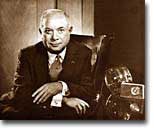
COMMERCIAL RADIO in America had humble beginnings. FRANK CONRAD, an engineer for Westinghouse, set up an amateur radio station above his garage in a Pittsburgh suburb. Since the wireless technology was developed byGUGLIELMO MARCONI in the late 19th century, thousands of enthusiasts across the world experimented with the new toy. After World War I, Conrad began broadcasting a variety of programming from his "station." High school music groups performed, phonograph records were played, and news and baseball scores were reported. Conrad had dramatically improved the TRANSMITTER, and soon hundreds of people in the Pittsburgh area were sending requests for air time. The bosses of Westinghouse knew that Conrad was on to something and convinced him to make his hobby commercially profitable.
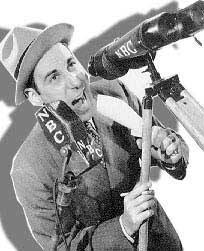
Sports broadcasts helped boost the popularity of radio.
KDKA on the Air
On the night of November 2, 1920, Conrad and his Westinghouse associates announced that WARREN G. HARDING had defeated JAMES COX to become the next President. The message was heard as far north as New Hampshire and as far south as Louisiana. The federal government granted the call letters KDKA to the Pittsburgh station and a new industry was born. For nearly a year, KDKA monopolized the airwaves. But competition came fast and furious; by the end of 1922, there were over 500 such stations across the United States. The federal government excercised no regulation over the nascent enterprise, and the result was complete chaos. Stations fought over call letters and frequencies, each trying to outbroadcast the closest competitor. Finally in 1927, Congress created the FEDERAL RADIO COMMISSION to restore order.
Ad Time
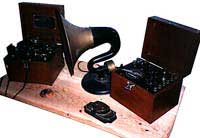
One of the great attractions to the radio listener was that once the cost of the original equipment was covered, radio was free. Stations made money by selling air time to advertisers. The possibility of reaching millions of listeners at once had advertising executives scrambling to take advantage. By the end of the decade advertisers paid over $10,000 for an hour of premium time.
The RADIO CORPORATION OF AMERICAcreated a new dimension to the venture in 1926. By licensing telephone lines, RCA created America's first radio network and called it the NATIONAL BROADCASTING COMPANY. For the first time, citizens of California and New York could listen to the same programming simultaneously. Regional differences began to dissolve as the influence of network broadcasting ballooned. Americans listened to the same sporting events and took up the same fads. Baseball games and boxing matches could now reach those far away from the stadiums and arenas. A mass national entertainment culture was flowering.
Fads and Heroes
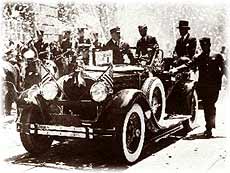
New American hero, Charles Lindbergh, is honored with a ticker-tape parade in New York City on June 13, 1927, after returning from the world's first solo transatlantic flight in the Spirit of St. Louis.
The Roaring Twenties was a time of great change. As exciting as dynamic times may seem, such turmoil generates uncertainty. Sometimes, in an effort to obscure tensions, people seek outlets of escape. FADS — sometimes entertaining, sometimes senseless — swept the nation. Another coping strategy in a time of great uncertainty is to find role models who embody tried and true values. National heroes heretofore unknown to peacetime America began to dominate American consciousness.

Flagpole sitting was a popular fad of the 1920s and was definitely the thing to do!
New Fads
The radio created the conditions for national fads. Without such a method of live and immediate communication, fads could amount only to local crazes. Roaring Twenties fads ranged from the athletic to the ludicrous. One of the most popular trends of the decade was the dance marathon. New dance steps such asTHE CHARLESTON swept the nation's dance halls, and young Americans were eager to prove their agility. In a typical dance marathon, contestants would dance for forty-five minutes and rest for fifteen. The longest marathons lasted thirty-six hours or more. Beauty pageants came into vogue. The first MISS AMERICA PAGEANT was staged in Atlantic City in 1921. One of the most bizarre fads was FLAGPOLE SITTING. The object was simple: be the person who could sit atop the local flagpole for the longest period of time. Fifteen-year-old AVON FOREMAN of Baltimore set the amateur standard — ten days, ten hours, ten minutes, and ten seconds.
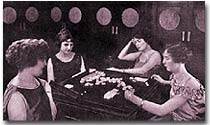
Flappers playing Mah Jongg, a popular board game, in the 1920s.
MAH-JONGG is a Chinese tile game. Colored tiles with different symbols were randomly arranged geometrically. The object is to remove all the game pieces.CROSSWORD PUZZLE fever swept the nation when Simon and Schuster published America's first crossword puzzle book. The BOOK-OF-THE-MONTH CLUB drew thousands of readers into literary circles. Two new periodicals began to grace American coffee tables. The nation's first weekly news magazine, TIME, was founded by HENRY LUCEand BRITON HADDEN. Their punchy writing on timely stories and eye-grabbing pictures hit the newsstands in 1923. DEWITT WALLACE made a business out of condensing articles from other periodicals. His publication, READER'S DIGEST, began in 1921 and boasted a half million subscriptions a decade later.
New Heroes
No individual personified the All-American hero more than CHARLES LINDBERGH. His courage was displayed to the nation when he flew his SPIRIT OF ST. LOUIS from New York to Paris, becoming the first man to fly solo across the Atlantic Ocean. National and international news was hidden in the back pages of the major newspapers while Lindbergh stole the front pages. Confetti flew and bugles sounded in New York City when he returned successfully, and President Coolidge hosted a gala celebration. There was more to Lindbergh's appeal than his bravery. Throughout the ordeal, Lindbergh maintained a hometown modesty. He declined dozens of endorsement opportunities, ever refusing to sell out. Spectator sports provided opportunities for others to grab the limelight. TY COBB and BABE RUTHwere role models for hundreds of thousands of American boys. Fortunately, Cobb's outward racism and Ruth's penchant for drinking and womanizing were shielded from admiring youngsters. Football had RED GRANGE, and boxing had JACK DEMPSEY. GERTRUDE EDERLE impressed Americans by becoming the first woman to swim the English Channel. These heroes gave Americans, anxious about the uncertain future and rapidly fading past, a much needed sense of stability.
